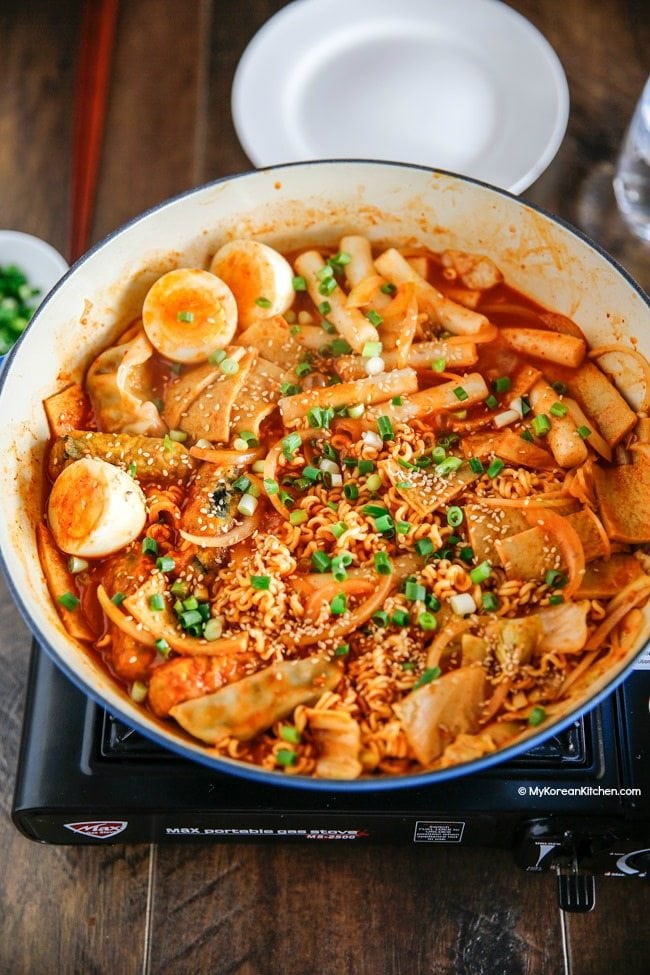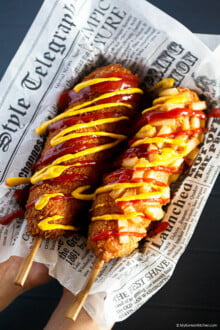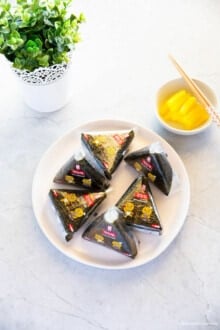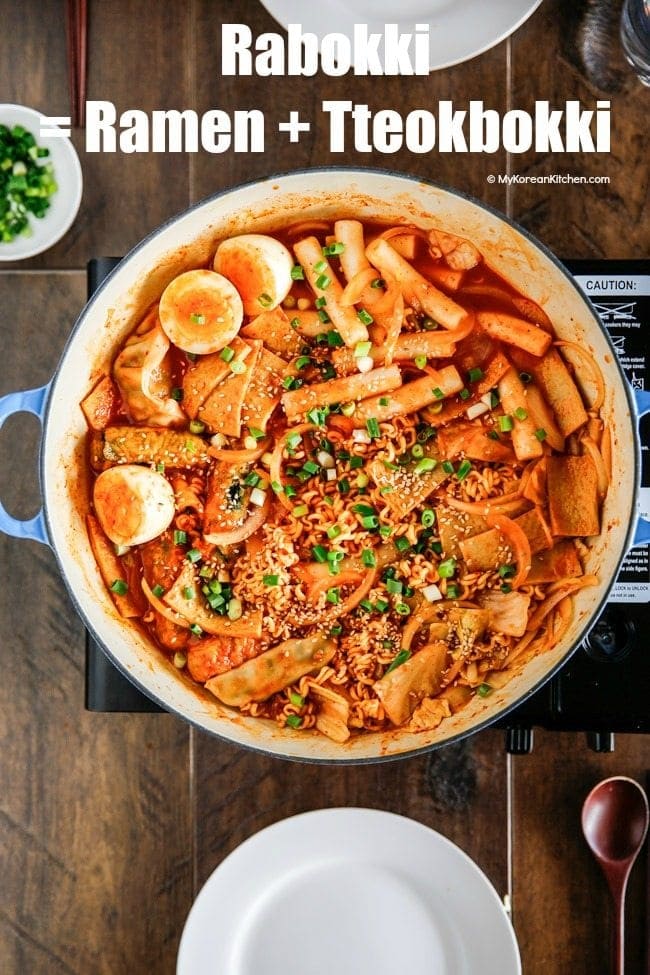
What is Rabokki
Rabokki (라볶이) is a Korean portmanteau for Ramyeon (라면, instant ramen noodles) and Tteokbokki (떡볶이, Korean spicy rice cakes). It is a popular dish to many Koreans, particularly amongst teenagers. It gives spicy, delicious and addictive flavor and is quite a filling food at a relatively cheap price. Probably that’s why it is popular.
I also prefer rabokki over tteokbokki as it often includes more interesting and delicious additional ingredients such as boiled eggs, ramen noodles, dumplings and so on, which aren’t normally added in tteokbokki.
What’s in Rabokki?
The standard ingredients that go into rabokki are Korean rice cakes, ramen noodles, Korean fish cakes, cabbage leaves, spicy gochujang sauce and hard boiled eggs (to top it up).
But some people add Korean instant dumplings and deep fried seaweed spring rolls as well, and they go wonderfully together!
Also, some people might choose to add chewy noodles (jjolmyeon, 쫄면) instead of ramen noodles. Some people even add Korean ramen seasoning powder in addition to the spicy gochujang sauce.
Another ingredient you could add is sliced cheese. I forgot to add it this time, but I try to add it if I can.
Anyway, try this soon! You will love it.
Ingredients for Rabokki (2 to 3 servings, as a main meal)
Main
- 1 instant ramen noodle pack
- Fresh Korean rice cakes 16 pieces (180g/6.3 ounces), separated, if you use pre-packaged or frozen rice cakes, separate them first then soak in warm water for 10 minutes before you use them.
- 2 sheets (110g / 3.9 ounces) of Korean fish cakes, rinsed under hot running water for 1 min, chopped into small rectangular pieces
- cabbage leaves (80g/2.8 ounces), chopped into small pieces
- 1/2 small onion (60g/2.1 ounces), thinly sliced
- 4 deep fried seaweed spring rolls (100g/3.5 ounces) – I bought them from a Korean grocery store (freezer section) but you can make them if you have the time.
- 2 instant Korean dumplings (45g/1.6 ounces)
- 2 hard boiled eggs, cut into halves
Broth
- 3 cups water
- 5g/0.2 ounces dried kelp
- 15g/0.5 ounces dried anchovy, head and black innards removed
Sauce (Mix them well in a bowl)
- 4 Tbsp gochujang (Korean chili paste)
- 1 and 1/2 Tbsp raw sugar
- 1 tsp minced garlic
- 1 tsp gochugaru (Korean chili flakes)
Garnish
- 1 stalk of green onion (20g/0.7 ounces), thinly chopped
- some roasted sesame seeds
*1 Tbsp = 15 ml, 1 cup = 250 ml
** If you want to learn more about Korean cooking ingredients, check my 30 essential Korean cooking ingredients list!
How to Make Rabokki
1. Put the water (3 cups) in a medium pot and add the dried kelp and anchovies. Boil it for 10 mins uncovered on medium heat. Take out (& discard) the kelp and continue boiling for a further 10 mins. Take out the anchovy. Sieve through the boiled broth over damp cheese/linen cloth to remove small particles from the kelp and anchovies. (If you don’t mind these particles, you can skip sieving.) This should result in about 400ml of broth. (Check here if you need step by step photo instructions for this process.)
2. Pour the broth into a wider pot, add the sauce and stir it well. Boil it over medium high heat. (I used a shallow pot and portable gas burner to enjoy Rabokki like a hot pot dish at the table.)
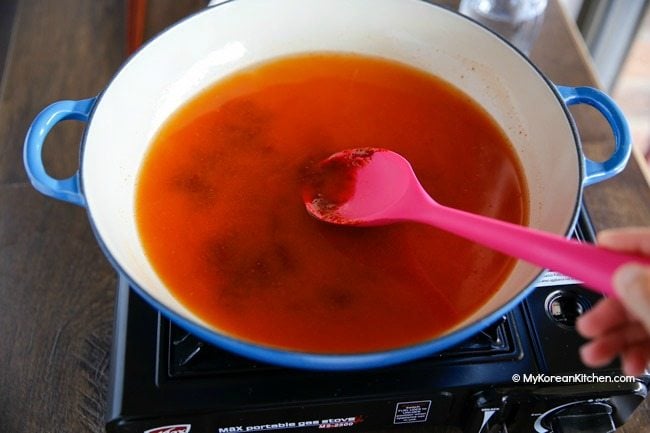
3. Once the broth starts to boil, reduce the heat to medium low. Add the rest of the ingredients and as they cook, stir around occasionally.

4. (If you’re cooking at the table) Add the garnish ingredients and start eating them as they get ready. Otherwise, serve when everything is cooked. Add the garnish ingredients just before serving.
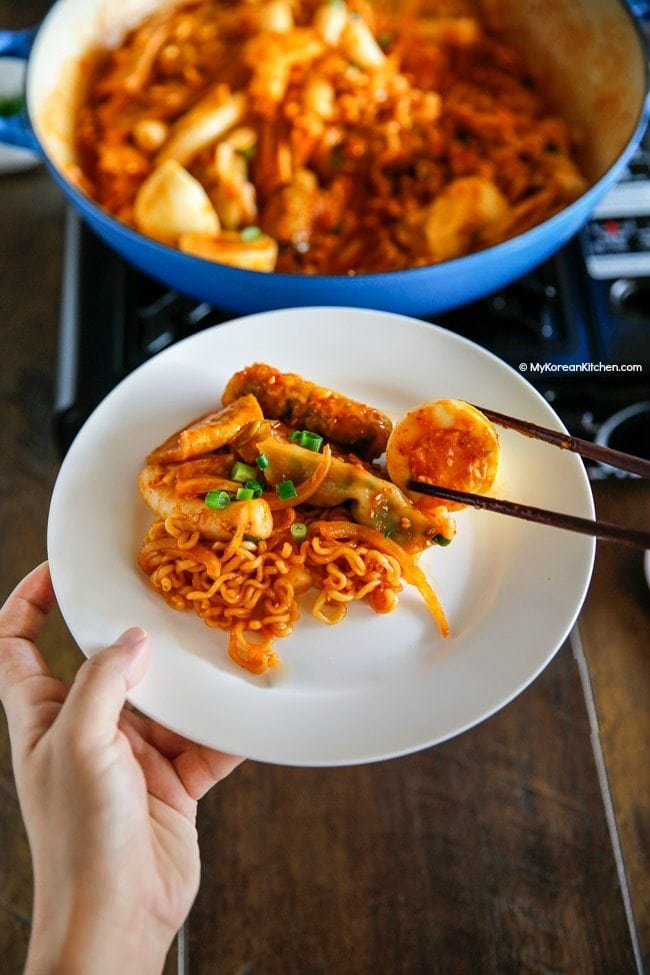
Note
- If you want to eat Rabokki more spicier, then adjust the sauce ratio by reducing gochujang (Korean chilli paste) and increasing gochugaru (Korean chili flakes).
Love Korean food? Browse lots more Korean recipes from my easy Korean recipe collections. And subscribe to my newsletter and follow along on Facebook, Pinterest and Instagram for all of the latest updates.
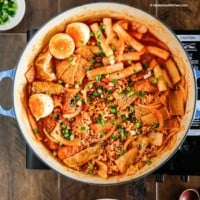
Rabokki - Ramen + Tteokbokki
Ingredients
Main
- 1 instant ramen noodle
- 16 pieces Korean rice cakes (180 g / 6.3 ounces), separated, if you use pre-packaged rice cakes, separate them first then soak in warm water for 10 minutes before you use them.
- 2 sheets Korean fish cakes (110 g / 3.9 ounces), rinsed under hot running water for 1 min, chopped into small rectangular pieces
- 80 g cabbage leaves (2.8 ounces), chopped into small pieces
- 1/2 small onion (60 g / 2.1 ounces), thinly sliced,
- 4 deep fried seaweed spring rolls (100 g / 3.5 ounces), I bought them from a Korean grocery store (freezer section) but you can make them if you have the time.
- 2 frozen Korean dumplings (45 g / 1.6 ounces)
- 2 hard boiled eggs , cut into halves
Broth
- 3 cups water
- 5 g dried kelp (0.2 ounces)
- 15 g dried anchovy (0.5 ounces), head and black innards removed
Sauce (Mix them well in a bowl.)
Garnish
- 1 stalk green onion (20 g / 0.7 ounces), thinly chopped
- some toasted sesame seeds
Instructions
- Put the water (3 cups) in a medium pot and add the dried kelp and anchovies. Boil it for 10 mins uncovered on medium heat. Take out (& discard) the kelp and continue boiling for a further 10 mins. Take out the anchovy. Sieve through the boiled broth over damp cheese/linen cloth to remove small particles from the kelp and anchovies. (If you don’t mind these particles, you can skip sieving.) This should result in about 400ml of broth. (Check here if you need step by step photo instructions for this process.)
- Pour the broth into a wider pot, add the sauce and stir it well. Boil it over medium high heat. (I used a shallow pot and portable gas burner to enjoy Rabokki like a hot pot dish at the table.)
- Once the broth starts to boil, reduce the heat to medium low. Add the rest of ingredients and as they cook, stir around occasionally.
- (If you're cooking at the table) Add the garnish ingredients and start eating them as they get ready. Otherwise, serve when everything is cooked. Add the garnish ingredients just before serving.
Notes
Nutrition Info (per serving)
The nutrition information shown is an estimate provided by an online nutrition calculator. It should not be considered a substitute for a professional nutritionist’s advice.
